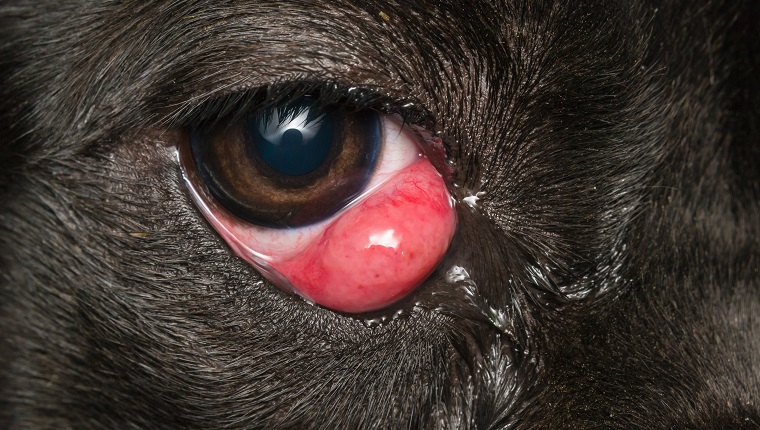Cherry eye in dogs happens when the nictitans gland, which normally sits behind your dog’s third eyelid, prolapses, meaning it moves out of place. A dog’s third eyelid protects their eyes, but sometimes the gland behind the eyelid can become irritated and pop out.
Veterinarians aren’t sure of an exact cause of the condition, but we do know that some breeds, like Cocker Spaniels and Bulldogs, are more prone to a prolapsed gland of the nictitating membrane than others. A dog could also develop a cherry eye if physical trauma stretched or tore a ligament keeping the gland in place.
The severity of the condition varies; some mild cases only require a warm compress, while others may require surgery to replace the third eyelid.
If you notice any unusual symptoms in your dog’s eyes, then you must contact your veterinarian for treatment and to make sure there aren’t any complications down the road. Here’s what you should know about the symptoms, causes, and treatments for cherry eye in dogs.
Symptoms Of Cherry Eye In Dogs
The most obvious sign of cherry eye in dogs is a swollen, pinkish-red membrane in the corner of one of the eyes.
Dogs may scratch or paw at their eye, as the swollen membrane is no longer doing its job of creating a protective tear film. If your dog scratches their eye, this can also inflict scratches on the cornea or other parts of the eye, which can lead to infection.
Here are some of the common symptoms that might appear in dogs:
- A swollen pink or red “blob” in the corner of the eye(s)
- Scratching or pawing at the eye
- Dry eye (due to the lack of tear production)
- Excessive blinking
- Discharge around the eye
Causes Of Cherry Eye In Dogs

While veterinarians aren’t always sure of the cause of cherry eye in every case, many point to stretched or torn ligaments in the third eyelid as a cause.
This strain could have come from a physical trauma, or, if the affected dog is a breed that’s prone to this ailment, the ligaments might be weaker, making it easier for the membrane to pop out from under the third eyelid.
Certain breeds and puppies under the age of one year old are the most susceptible to cherry eye. The Cocker Spaniel is one of the most common breeds to suffer from this ailment, along with other Spaniels. Bulldogs are also prone to this eye condition.
Here are several possible causes of cherry eye in dogs:
- Breed predisposition
- Age (puppies one year and younger have higher risk)
- Physical trauma to the eye
- Excessive scratching or pawing of the eye
Treatment Of Cherry Eye In Dogs
The most important thing to do as soon as you notice your dog may be suffering from cherry eye is to contact your veterinarian. After an exam, your vet will be able to properly come up with a treatment plan.
Vets often recommend surgery to correct the third eyelid in order to keep dogs from developing dry eye or other eye conditions. This option sometimes doesn’t always stick, as cherry eye relapse can happen post-surgery a few months down the line.
Other times, if the issue is small enough or does not threaten your dog’s eye health, a veterinarian might suggest a warm compress, rest, and simply letting the cherry eye be. Whatever the case, it’s vital that you talk to your veterinarian and keep your dog’s eyes healthy!
Has your dog ever suffered from cherry eye? What did you do to treat it? Let us know how you took care of your dog in the comments below!









